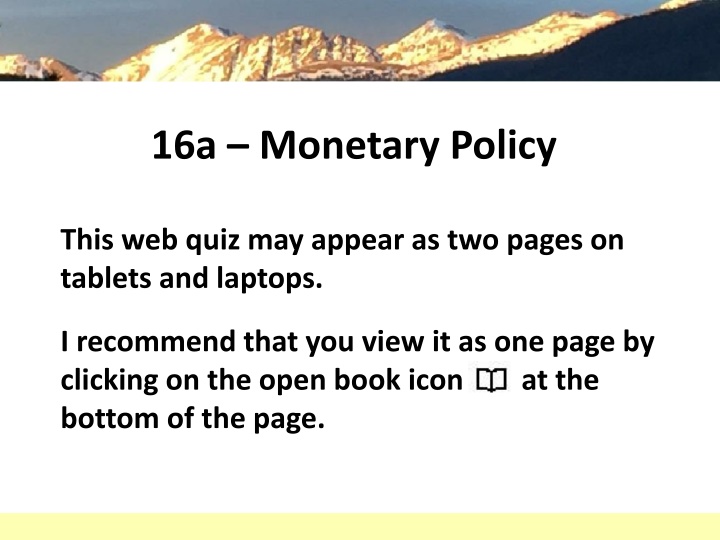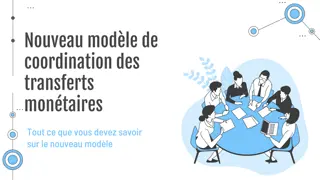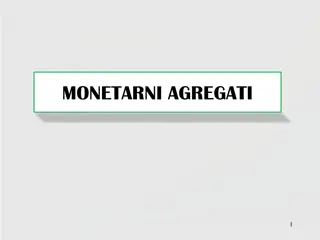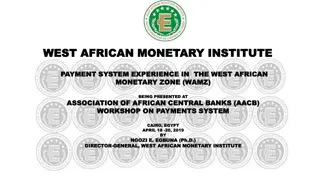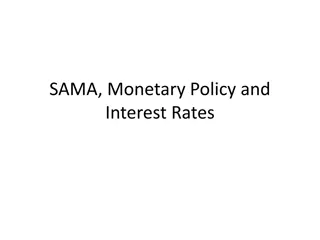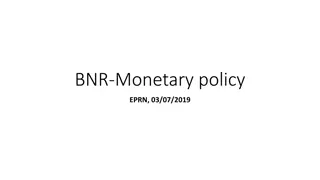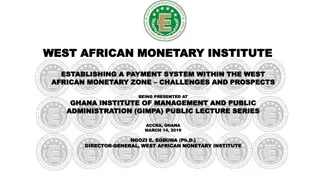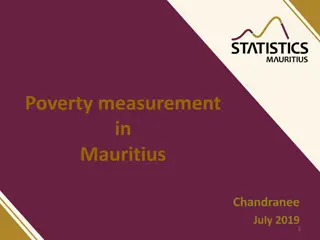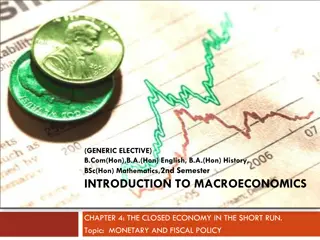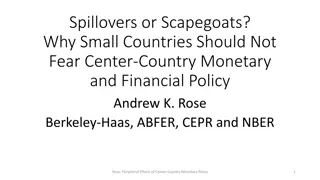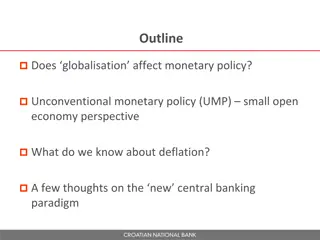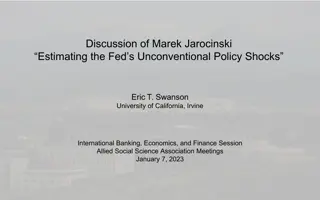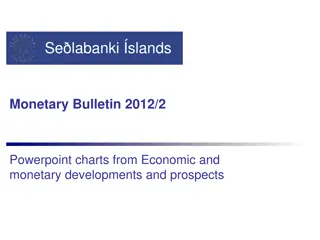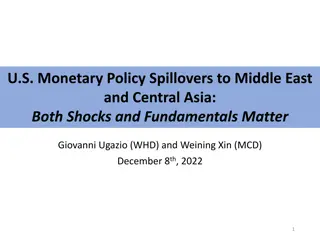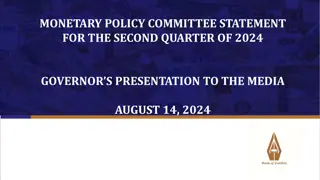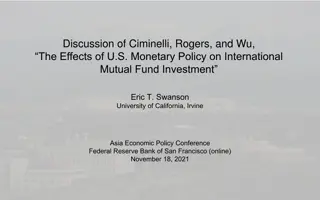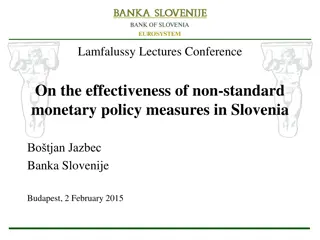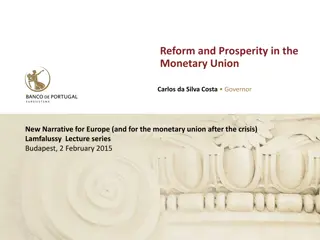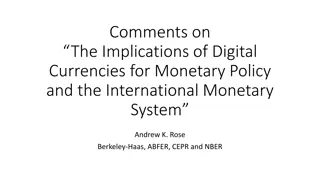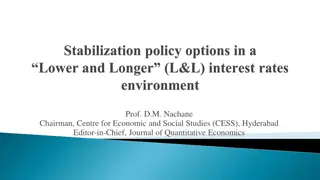Monetary Policy Tools
Key concepts of monetary policy, including the tools used by the Federal Reserve to manage the money supply, impact interest rates, and influence the economy. Learn about open market operations, discount rates, reserve ratios, and more.
Download Presentation

Please find below an Image/Link to download the presentation.
The content on the website is provided AS IS for your information and personal use only. It may not be sold, licensed, or shared on other websites without obtaining consent from the author.If you encounter any issues during the download, it is possible that the publisher has removed the file from their server.
You are allowed to download the files provided on this website for personal or commercial use, subject to the condition that they are used lawfully. All files are the property of their respective owners.
The content on the website is provided AS IS for your information and personal use only. It may not be sold, licensed, or shared on other websites without obtaining consent from the author.
E N D
Presentation Transcript
16a Monetary Policy This web quiz may appear as two pages on tablets and laptops. I recommend that you view it as one page by clicking on the open book icon at the bottom of the page.
16a Monetary Policy Tools of the Fed OMO (Open Market Operations) DR (Discount Rate) RR (Required Reserve Ration) The Monetary Policy Cause Effect Chain
16a Monetary Policy Must Know / Outcomes: List the principal assets and liabilities of the Federal Reserve Banks. Explain how each of the three tools of monetary policy may be used by the Fed to expand and to contract the money supply. Explain the relative importance of the monetary policy tools. (OMO most important) Describe expansionary and contractionary monetary policies, and explain when, why, and how they are used. Describe the relationship between the interest rate, expected rate of return, and investment and construct an investment demand curve. Identify the factors (determinants) that may cause a shift in the investment-demand curve. Explain the cause-effect chain between monetary policy and changes in equilibrium GDP. Demonstrate graphically the money market and how a change in the money supply will affect the interest rate. Show the effects of interest rate changes on investment spending. Describe the impact of changes in investment on aggregate demand, equilibrium GDP, and UE, IN, and EG. Describe how the Fed targets the Federal Funds Rate (Fed Funds) as part of its OMO monetary policy actions. Listen to the first minute and ten seconds of the podcast below. Can you GRAPH what is happening in China? (The first two minutes are NOT about basketball in Cuba.) http://www.marketplace.org/topics/economy/podcast-basketball-heads-cuba
16a Monetary Policy KEY TERMS: expected rate of return, investment demand, assets of the Federal Reserve banks, liabilities of the Federal Reserve banks, Federal Reserve notes, Open Market Operations (OMO), Discount Rate (DR), Required Reserve Ratio (RR), Federal funds rate (Fed funds)
Tools of the Fed OMO (Open Market Operations) DR (Discount Rate) RR (Required Reserve Ratio)
1. Assume the RR is 20% and a $10 bill in deposited in a checking account of Bank A. How much does the money creation potential increase for Bank A and for the banking system? 1. Bank A s $10; banking system s $50 2. Bank A s $8; banking system s $40 3. Bank A s $10; banking system s $20 4. Bank A s $8; banking system s $20
1. Assume the RR is 20% and a $10 bill in deposited in a checking account of Bank A. How much does the money creation potential increase for Bank A and for the banking system? 1. Bank A s $10; banking system s $50 2. Bank A s $8; banking system s $40 3. Bank A s $10; banking system s $20 4. Bank A s $8; banking system s $20
FORMULAS: ER = Total Reserves - Req. Res (Bank A can increase MS by ER) Change in MS = ER x Multiplier (Use for the banking system ) Money Multiplier = 1/RR
FORMULAS: ER = Total Reserves - Req. Res Change in MS = ER x Money Multiplier Money Multiplier = 1/RR IF: RR is 20% and a $10 bill in deposited: Money Multiplier = 1/RR = 1/.20 = 5 Req. Res = RR x Liabilities = .20 x $10 = $2 ER = Total Reserves Req. Res = $10 $2 = $8 Change in MS = ER x Money Multiplier Change in MS = $8 x 5 = $40.
2. Assume the RR is reduced to 10% and a $10 bill in deposited in a checking account of Bank A. How much does the money creation potential increase for Bank A and for the banking system? 1. Bank A s $8; banking system s $40 2. Bank A s $8; banking system s $80 3. Bank A s $9; banking system s $45 4. Bank A s $9; banking system s $90 Tools of the Fed: RR
2. Assume the RR is reduced to 10% and a $10 bill in deposited in a checking account of Bank A. How much does the money creation potential increase for Bank A and for the banking system? 1. Bank A s $8; banking system s $40 2. Bank A s $8; banking system s $80 3. Bank A s $9; banking system s $45 4. Bank A s $9; banking system s $90 Tools of the Fed: RR
FORMULAS: Change in MS = ER x Money Multiplier ER = Total Reserves - Req. Res Money Multiplier = 1/RR RR is reduced to 10% and a $10 bill in deposited Money Multiplier = 1/RR = 1/.10 = 10 Req. Res = RR x Liabilities = .10 x $10 = $1 ER = Total Reserves Req. Res = $10 $1 = $9 Change in MS = ER x Money Multiplier Change in MS = $9 x 10 = $90. Tools of the Fed: RR
Changing the reserve ratio (RR) has two effects: a. It affects the size of excess reserves. RR 20% and $10 deposited: ER = 8 RR 10% and $10 deposited: ER = 9 b. It also changes the size of the monetary multiplier. RR 20%: multiplier = 5 RR 10%: multiplier = 10 ER x money multiplier = Change in MS 8 x 5 = 50 9 x 10 = 90 Therefore it is very disruptive and is seldom used. Tools of the Fed: RR
Tools of the Fed OMO DR RR Decrease in the RR increases ER and therefore increase the MS Increase in the RR decreases ER and therefore decrease the MS
3. What are OMO? 1. The rate the Fed pays banks for their reserves 2. Overnight loans made by banks to other banks 3. The Fed buys or sells securities to change the MS 4. The fraction of liabilities that banks must keep Tools of the Fed: OMO
3. What are OMO? 1. The rate the Fed pays banks for their reserves 2. Overnight loans made by banks to other banks 3. The Fed buys or sells securities to change the MS 4. The fraction of liabilities that banks must keep Tools of the Fed: OMO
4. Which of the following is correct about the balance sheet of the Fed? 1. Securities are a liability 2. Reserves of banks are a liability 3. US treasury deposits are an asset 4. Loans to banks are a liability 5. Federal reserve notes are an asset Tools of the Fed: OMO
4. Which of the following is correct about the balance sheet of the Fed? 1. Securities are a liability 2. Reserves of banks are a liability 3. US treasury deposits are an asset 4. Loans to banks are a liability 5. Federal reserve notes are an asset Tools of the Fed: OMO
5. Assume that the Fed buys a $1000 bond (security) from COMMERCIAL BANKS (RR = 20%), What is the max. possible increase in the MS? 1. $200 2. $1000 3. $4000 4. $5000 5. $10,000 Tools of the Fed: OMO
5. Assume that the Fed buys a $1000 bond (security) from a COMMERCIAL BANKS (RR = 20%), What is the max. possible increase in the MS? 1. $200 2. $1000 3. $4000 4. $5000 5. $10,000 Tools of the Fed: OMO
FORMULAS: Change in MS = ER x Money Multiplier ER = Total Reserves - Req. Res Money Multiplier = 1/RR Fed buys a $1000 bond from a BANK (RR = 20%), Money Multiplier = 1/RR = 1/.20 = 5 Req. Res = RR x Liabilities = .20 x $0 = $0 ER = Total Reserves Req. Res = $1000 $0 = $1000 Change in MS = ER x Money Multiplier Change in MS = $1000 x 5 = $5000. Tools of the Fed: OMO
6. Assume that the Fed buys a $1000 bond (security) from THE PUBLIC (RR = 20%), What is the max possible increase in the MS? 1. $200 2. $1000 3. $4000 4. $5000 5. $10,000 Tools of the Fed: OMO
6. Assume that the Fed buys a $1000 bond (security) from THE PUBLIC (RR = 20%), What is the max possible increase in the MS? 1. $200 2. $1000 3. $4000 4. $5000 5. $10,000 Tools of the Fed: OMO
FORMULAS: Change in MS = ER x Money Multiplier ER = Total Reserves - Req. Res Money Multiplier = 1/RR Fed buys a $1000 bond from PUBLIC (RR = 20%), Money Multiplier = 1/RR = 1/.20 = 5 Req. Res = RR x Liabilities = .20 x $1000 = $200 ER = Total Reserves Req. Res = $1000 $200 = $800 Change in MS = ER x Money Multiplier Change in MS = $800 x 5 = $4000. PLUS the original $1000 deposited in bank by PUBLIC Change in MS = $4000 + $1000 = $5000 Tools of the Fed: OMO
Tools of the Fed OMO BUY securities increases ER and therefore increase the MS SELL securities decreases ER and therefore decrease the MS DR RR Decrease in the RR increases ER and therefore increase the MS Increase in the RR decreases ER and therefore decrease the MS
7. The Discount rate (DR) is charged by _______ to ________ for _________ . 1. The Fed / banks / loans 2. Banks / the Fed / reserves 3. Fed; banks; reserves 4. Banks / other banks / overnight loans Tools of the Fed: DR
7. The Discount rate (DR) is charged by _______ to ________ for _________ . 1. The Fed / banks / loans 2. Banks / the Fed / reserves 3. Fed; banks; reserves 4. Banks / other banks / overnight loans Tools of the Fed: DR
8. Assume the RR is 20% and the Fed lowers the DR which results in banks borrowing $10 billion. How much does this change the money creation potential for the banking system? 1. $10 2. $40 3. $50 4. $200 Tools of the Fed: DR
8. Assume the RR is 20% and the Fed lowers the DR which results in banks borrowing $10 billion. How much does this change the money creation potential for the banking system? 1. $10 2. $40 3. $50 4. $200 Tools of the Fed: DR
FORMULAS: Change in MS = ER x Money Multiplier ER = Total Reserves - Req. Res Money Multiplier = 1/RR RR is 20%, Fed lowers the DR, banks borrow $10 Money Multiplier = 1/RR = 1/.20 = 5 Req. Res = RR x Liabilities = .20 x $0 = $0 ER = Total Reserves Req. Res =$10 $0 = $10 Change in MS = ER x Money Multiplier Change in MS = $10 x 5 = $50. Tools of the Fed: DR
DISCOUNT RATE Definition: the interest rate that the Fed charges to commercial banks that borrow from the Fed. An increase in the discount rate signals that borrowing reserves is more difficult and will tend to shrink excess reserves. A decrease in the discount rate signals that borrowing reserves will be easier and will tend to expand excess reserves. Tools of the Fed: DR
Tools of the Fed OMO BUY securities increases ER and therefore increase the MS SELL securities decreases ER and therefore decrease the MS DR Increase the DR decreases ER and therefore decrease the MS Decrease the DR increases ER and therefore increase the MS RR Decrease in the RR increases ER and therefore increase the MS Increase in the RR decreases ER and therefore decrease the MS
9. Which tool does the Fed use most often? 1. OMO 2. RR 3. DR Tools of the Fed
9. Which tool does the Fed use most often? 1. OMO 2. RR 3. DR Tools of the Fed
For several reasons, Fed uses open- market operations most often: 1. Open-market operations are most important. This decision is flexible because securities can be bought or sold quickly and in great quantities. Reserves change quickly in response. 2. The reserve ratio is rarely changed since this could destabilize bank s lending and profit positions. 3. Changing the discount rate has little direct effect, since only 2-3 percent of bank reserves are borrowed from Fed. At best it has an "announcement effect" that signals direction of monetary policy. Tools of the Fed
10. The Federal Funds interest rate (Fed. Funds) is charged by _______ to ________ for _________ . 1. The Fed / banks /overnight loans 2. Banks / the Fed / reserves 3. Fed / banks / reserves 4. Banks / other banks / overnight loans
10. The Federal Funds interest rate (Fed. Funds) is charged by _______ to ________ for _________ . 1. The Fed / banks /overnight loans 2. Banks / the Fed / reserves 3. Fed / banks / reserves 4. Banks / other banks / overnight loans
11. If you read that the Fed is raising the Fed funds rate then which tool are they using? 1. OMO 2. DR 3. RR
11. If you read that the Fed is raising the Fed funds rate then which tool are they using? 1. OMO 2. DR 3. RR
12. What is the CORRECT order? 1. Fed tool => ER => Interest Rate => MS => I=> AD 2. Fed tool => Interest Rate => ER => MS => I=> AD 3. Fed tool => ER => MS => Interest Rate => I=> AD 4. Fed tool => Interest Rate => MS => ER => I=> AD
12. What is the CORRECT order? 1. Fed tool => ER => Interest Rate => MS => I=> AD 2. Fed tool => Interest Rate => ER => MS => I=> AD 3. Fed tool => ER => MS => Interest Rate => I=> AD 4. Fed tool => Interest Rate => MS => ER => I=> AD
13. If the graph at the right represents the current economy, what should the Fed do? 1. Decrease the MS 2. Increase the DR 3. Increase the RR 4. Buy Securities
13. If the graph at the right represents the current economy, what should the Fed do? 1. Decrease the MS 2. Increase the DR 3. Increase the RR 4. Buy Securities
